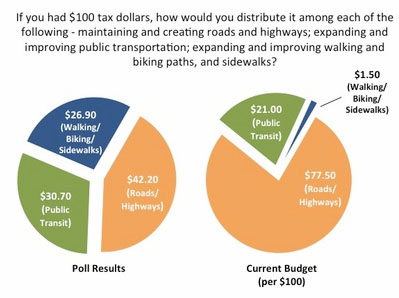Should Congress be the ones to deliver more and better transportation infrastructure, or should we?
Now that the cromnibus crisis is crover, it’s not too soon to remember that the current federal surface transportation spending authorization is going to run out in six months. Before things get down to the wire, we should remind ourselves of why surface transportation finance has become such a messy issue.

Results from a recent focus group study on transportation funding. Image by Lake Research Partners and Bellweather Research and Consulting.
Last summer, Congress allowed the Highway Trust Fund (HTF) to nearly go bankrupt before providing a last-minute bailout. But that infusion from the General Fund, along with a dozen short-term extensions and authorizations, is the type of money that’s kept federal surface transportation limping along since the last long-term authorization expired in 2009.
Ever since, the federal government has dispensed funds in a way that keeps infrastructure maintenance and construction on a flatline, short-term budget while requiring states and regions to provide plans for the long-term. It doesn’t make sense.
The federal surface transportation program currently has no vision; it’s a formula rather than a dynamic plan. And in five years of waiting, neither the Obama administration nor members of Congress have filled the void.
A big part of the problem is that transportation has lost the public’s trust
Congress is unlikely to raise the gas tax even as prices plummet. We’re all completely fed up with crumbling roads and incomplete streets. But instead of blaming a do-nothing Congress, transportation professionals need to confront the fact that actually no one wants to dedicate revenue to our work because the American transportation planning process is opaque and technocratic, wasteful, and unresponsive to public priorities. Some even call it elitist.
Our region has certainly fallen victim to this dynamic. In 2013, a series of focus groups led by the Transportation Planning Board of the Metropolitan Washington Council of Governments in DC, Maryland, and Virginia showed that people are generally against attempts to increase revenue for transportation.
But after group participants considered alternatives, like increased tolling or a instituting a charge on vehicle miles traveled, support for increasing the gas tax rose from 21 percent to a majority of 57 percent. Even more telling, a whopping three-quarters of focus group participants wanted more money to go to transit, and 58 percent backed more funding for pedestrian and bicycle projects. Directing new revenue to roads came last, at 53 percent.
A recent national poll by a bipartisan pollster team (and sponsored by my employer, the Rails-to-Trails Conservancy) found similar results across party lines, demographic groups, and geographic regions among likely 2016 voters. When asked to distribute a hypothetical $100 in tax dollars among highways, transit, and pedestrian and bike infrastructure, voters divided the money far more evenly among these three pots than Congress currently does.
There is a clear difference between the public’s priorities and what the current planning process serves up. Voters of all kinds would support funding transportation infrastructure if we addressed this cognitive dissonance.
Crowdsourcing is a new way for the public to get involved in financing and supporting transportation projects
The federal government could take the wheel in realigning how it invests in transportation infrastructure to match public priorities. But is it likely to do so?
A lot of people are tired of waiting to find out. As an alternative to hoping for money from Washington, staff from the crowd-resourcing platform ioby recently gathered in DC with transit, walking, and bicycling advocates to brainstorm ways to apply their grassroots funding model to projects in the Washington region.
Participants noted that crowd sourcing doesn’t just bring purchasing power, but also an opportunity for donors to show political and emotional buy-in for projects in their communities. And while crowdfunding isn’t going to build a billion dollar bridge or transit line, a project leader in Memphis recently used the platform to raise matching funds to leverage $4.5 million in other funding to build a two-mile protected bike lane.
Perhaps this new form of civic engagement for transportation projects will help push our leaders toward a new vision for American surface transportation.
